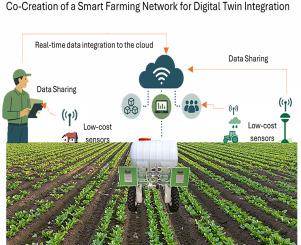Co-creating a data-driven smart farming sensor networks for digital twin integration in Irish tillage farming
IF 7.6
3区 计算机科学
Q1 COMPUTER SCIENCE, INFORMATION SYSTEMS
引用次数: 0
Abstract
Smart farming, integrating real-time environmental monitoring of soil and weather parameters, plays a critical role in advancing sustainable agriculture, improving productivity, and enhancing food security. In Ireland, the tillage sector supports approximately 10,000 farms contributing significantly to the national economy through cereal production. However, the sector faces mounting pressure to align with environmental regulations aimed at reducing greenhouse gas emissions, and soil and water pollution. There is a lack of established frameworks for on-farm environmental indicators monitoring. This study presents a pilot implementation of sensor-based monitoring within a Living Lab approach, emphasizing co-creation with tillage farmers. Through farmer engagement during farm visits and agricultural exhibitions, critical user requirements were identified as access to weather (64.7 %) and soil data (51.0 %), with 73.2 % preferring digital access. An Internet of Things-enabled system was deployed, capturing air temperature, humidity, and soil parameters (temperature, moisture, nutrients, electrical conductivity, and pH). The system allows for continuous, real-time data collection, overcoming limitations of traditional data acquisition methods. Data were transmitted and visualized on a web-based dashboard. The initial mean values were air temperature (11.9 °C), soil temperature (13.4 °C), humidity (70.55 %), nitrogen (10 mg/kg), phosphorus (3 mg/kg), potassium (40 mg/kg), pH (6.99), and EC (0.61 dS/m) which were within expected ranges for Irish conditions. These real-time data streams provide a foundation for digital twin development to later enable advanced analytics, predictive modelling, and informed decision-making. This pilot underscores the feasibility and value of smart farming approaches to enhance environmental compliance, sustainability, and policy alignment in Ireland’s tillage sector.

共同创建数据驱动的智能农业传感器网络,用于爱尔兰耕作农业的数字孪生集成
智能农业整合了对土壤和天气参数的实时环境监测,在推进可持续农业、提高生产力和加强粮食安全方面发挥着关键作用。在爱尔兰,耕作部门支持着大约10,000个农场,通过谷物生产为国民经济做出了重大贡献。然而,该行业面临着越来越大的压力,需要与旨在减少温室气体排放、土壤和水污染的环境法规保持一致。缺乏监测农场环境指标的既定框架。本研究提出了在生活实验室方法中基于传感器的监测的试点实施,强调与耕作农民共同创造。通过农民在农场参观和农业展览期间的参与,关键用户需求被确定为获得天气(64.7%)和土壤数据(51.0%),73.2%的人更喜欢数字访问。部署了一个物联网系统,可以捕获空气温度、湿度和土壤参数(温度、湿度、养分、电导率和pH值)。该系统可以实现连续、实时的数据采集,克服了传统数据采集方法的局限性。数据在基于网络的仪表板上传输和可视化。初始平均值为空气温度(11.9°C)、土壤温度(13.4°C)、湿度(70.55%)、氮(10 mg/kg)、磷(3 mg/kg)、钾(40 mg/kg)、pH(6.99)和EC (0.61 dS/m),均在爱尔兰条件的预期范围内。这些实时数据流为数字孪生体的开发提供了基础,以实现高级分析、预测建模和明智的决策。该试点强调了智能农业方法在提高爱尔兰耕作部门的环境合规性、可持续性和政策一致性方面的可行性和价值。
本文章由计算机程序翻译,如有差异,请以英文原文为准。
求助全文
约1分钟内获得全文
求助全文
来源期刊

Internet of Things
Multiple-
CiteScore
3.60
自引率
5.10%
发文量
115
审稿时长
37 days
期刊介绍:
Internet of Things; Engineering Cyber Physical Human Systems is a comprehensive journal encouraging cross collaboration between researchers, engineers and practitioners in the field of IoT & Cyber Physical Human Systems. The journal offers a unique platform to exchange scientific information on the entire breadth of technology, science, and societal applications of the IoT.
The journal will place a high priority on timely publication, and provide a home for high quality.
Furthermore, IOT is interested in publishing topical Special Issues on any aspect of IOT.
 求助内容:
求助内容: 应助结果提醒方式:
应助结果提醒方式:


